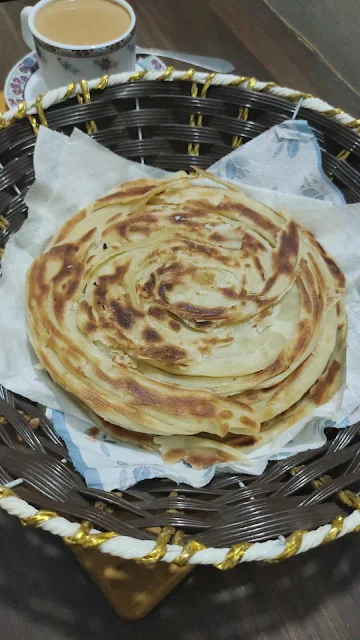Lachha paratha | layered paratha || How to make layered paratha with step-by-step photos and Video
Lachha Paratha is a unique flatbread that can be made of both wheat flour and all-purpose flour. It is crispy and flaky, with layers visible from the outside. Lachha Paratha looks more like a ‘pinwheel cookie’. Once you start eating it, it will melt in your mouth, and you will feel that the layers are coming off one by one.
Most importantly, traditionally, it is fried only with ghee. But these days, any
kind of cooking oil is used. Sometimes oil is mixed with a small amount of ghee. It's very tasty, besides being crispy. Paratha is generally prepared from wheat and all-purpose flour mixed together
It can only be made from maida(all-purpose flour). The main ingredients are added sugar, salt, egg, butter, and milk powder. It serves as breakfast, and as well as can also be given to the kids' lunch boxes
Here is the recipe for Lachha Paratha or Crispy Flaky Layered Pakistani Flatbread. Let the go-ahead know how to make this layered paratha...
If you have tried this Lachha Paratha Recipe, then don’t forget to rate the recipe. You can also follow me on social media to see what’s latest in my kitchen!
Like Our Videos? Then follow and subscribe to us on YouTube for the latest Recipe Video updates.
Take a big bowl, sieve the flour together, mix it, and make a small pit in the center of the flour. Now add salt, sugar, egg, and milk powder
Mix them well until they turn into a crumbly texture
Add water gradually and start kneading a soft dough. The dough seems to be sticky,
Add water gradually and start kneading a soft dough. The dough seems to be sticky,
Knead it with some ghee/butter, make a ball, and put it back into a bowl.
Keep aside for about 15 minutes
Take the dough out of the bowl and knead the dough again with an oily hand for a minute
Take some extra flour on the plate for dusting
and roughly divided the dough into equal parts(ball size depends on how thick you want to make the Rotis
and roughly divided the dough into equal parts(ball size depends on how thick you want to make the Rotis
Take one ball of dough and roll it out with the help of a rolling pin approximately 5 to 6 inches in a round shape, apply butter/ghee over the roti with the brush, and sprinkle some flour dust
Here starts the tricky part: fold the roti like a fan till you reach the end, hold it from the two opposite ends,
And tap the dough on the counter to stretch the roti. Further, to understand, follow the figure below
Preheat the Tava for 10 minutes
Warm the pan on medium flame, add 1 tbsp ghee, and place the paratha. Cook for 1-2 minutes and flip.
Add another 1 tbsp ghee/butter and cook till golden brown (use additional ghee/butter if required), cook for a further 2-3 minutes.
Repeat the same process with all remaining dough balls
Laccha paratha is a unique paratha that can be made of both wheat flour and all-purpose flour. It is a layered flatbread that is crispy and flaky
Ingredients:
- 2 cups all-purpose flour or fine flour
- 1/2 cup wheat flour
- 1/4 tsp salt
- 1 tsp sugar
- 1 large egg beaten
- 1 tbsp milk
- 2 tbsp butter/ghee melted at room temperature
- Warm water, for kneading dough
- 1 cup, melted ghee/butter for frying paratha
How to make the Layered Paratha?
- Take a big bowl, sieve the flour together, and mix it
- Make a small pit in the center of the flour
- Now add salt, sugar, egg, milk powder, and mix them well until they turn into a crumbly texture
- Add water gradually and start kneading a soft dough
- The dough seems to be sticky, knead it with some ghee/butter make a ball, and put it back into a bowl.
- Keep aside for about 15 minutes
- Take the dough out of the bowl and knead the dough again with an oily hand for a minute
- Take some extra flour on the plate for dusting
- and roughly divided the dough into equal parts(ball size depends on how thick you want to make the roties)
- Take one ball of dough and roll it out with the help of a rolling pin, approximately 5 to 6 inches in a round shape
- Apply butter/ghee over the roti with the brush and sprinkle some flour dust
- Here starts the tricky part: fold the roti like a fan till you reach the end, hold from the two opposite ends, and tap the dough on the counter to stretch the roti.
- Further, to understand, follow the above figure
- Gently start rolling the roti like a snail, press the end gently in the middle, cover, and keep in the fridge for 20 minutes.
- Preheat the Tava for 10 minutes
- Warm the pan on medium flame, add 1 tbsp ghee, and place the paratha. Cook for 1-2 minutes and flip.
- Add another 1 tbsp ghee/butter and cook till golden brown (use additional ghee/butter if required), cook for a further 2-3 minutes.
- Repeat the same process with all remaining dough balls
- Now ready to serve hot with kebab, omelet
*Not be duplicated, rewritten, or published without permission- Thank
you!



















Have you any doubts about this blog kindly let me know
EmoticonEmoticon